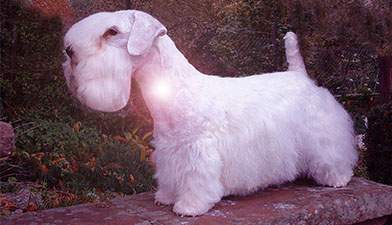
 The Sealyham Terrier is a famous non shedding dog
The Sealyham Terrier is a famous non shedding dog
Created in the 19th century by Capn John Edwards the Sealyham terrier looks very similar to the white Scottish Terrier. This dogs has many different breeds involved in its making: West Highland, White Terrier, Dandie Dinmont Terrier, Corgi, Wire-haired Fox Terrier, and the Bull Terrier.
Note that only some of these breeds are non shedding, yet the resulting dog is very NON shedding.
The Sealyham Terrier was also created for a purpose, hunting badger, fox and otter. Besides its low to the ground nature, another unique physical characteristic that was purposely created was its white coat so that it would not be confused with the prey.
Like many terriers this dog is described as independent, active, courageous, yet affectionate and good with families. That said, young children should be trained not to tease them and how to remain leaders to them. Unlike other terriers they have a healthy distrust of strangers, which leads to the requirement of daily socialization off lead so that they don’t extent this trait to their immediate family.
They are better than average in their reaction with other pets, once you have laid the ground rules.
Exercise should prevent possible downsides of separation anxiety, excessive barking and dog aggression
Because of its independent nature, training can be more difficult than usual, though a calm assertive trainer will go a long way towards taming this beast.
The perfect reward for this dog is to allow it to hunt and track in safe areas. Around your house it will also be a very good watchdogs and keeping the vermin population down.
Sealyham Terrier size: 30 cm and 10 kg
Sealyham Terrier grooming: This terrier has a double coat that is wiry and strong on the outside and soft on the inside. The coat is medium to long if not cut to length regularly. The colors you can expect are white, lemon, tan. Because of the coats tough nature, you may require stripping from time to time. Brushing every two weeks will keep matting down.
So in summary small pets are generally OK with them (as long as they are not mice or rats, and older children are preferred. Strangers may get no love from them, and they can be dog aggressive unless regularly socialised. They can make a great asset to the right family.